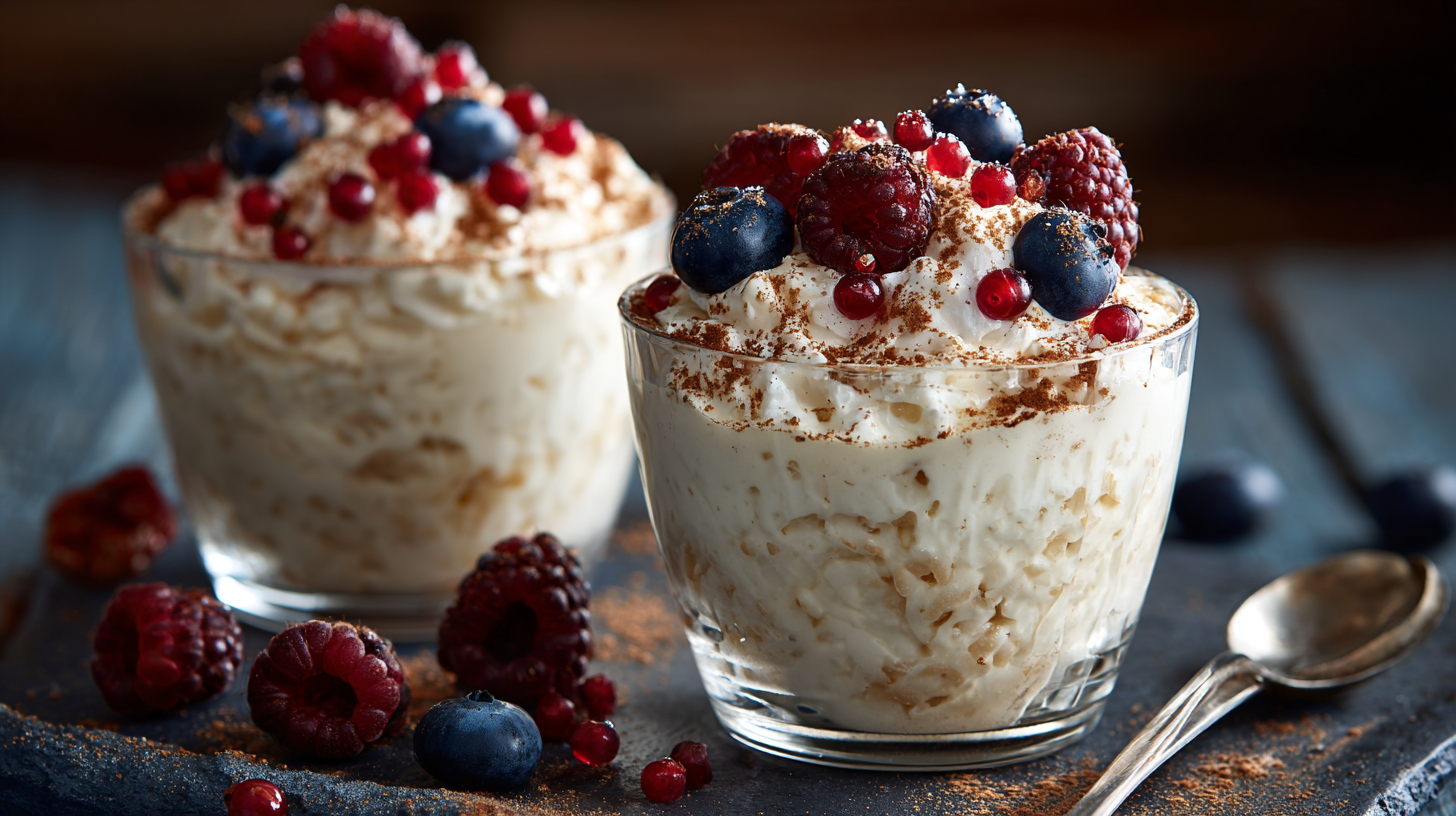The Best Rice Pudding Recipe
This foolproof rice pudding recipe combines simple ingredients to create a dessert that’s both comforting and elegant. Follow these straightforward steps to achieve the perfect creamy consistency that will have everyone asking for seconds.
Ingredients
- 1 cup short-grain white rice (such as Arborio)
- 2 cups water
- 4 cups whole milk
- 1/2 cup granulated sugar
- 1/4 teaspoon salt
- 2 teaspoons vanilla extract
- 1 tablespoon butter
- 2 large eggs (optional for extra richness)
- 1/2 cup raisins (optional)
- 1 teaspoon ground cinnamon (plus more for garnish)
- Nutmeg for garnish (optional)
Instructions
- Rinse the rice thoroughly under cold water until the water runs clear to remove excess starch.
- Combine rice and water in a medium saucepan. Bring to a boil over high heat then reduce to low heat and simmer covered for about 15 minutes until water is absorbed.
- Add milk sugar and salt to the cooked rice. Stir well to combine all ingredients.
- Cook the mixture over medium-low heat stirring frequently to prevent the rice from sticking to the bottom of the pan. This process takes approximately 25-30 minutes until the pudding reaches a creamy consistency.
- For an extra rich version whisk eggs in a separate bowl. Temper the eggs by slowly adding a small amount of the hot rice mixture while whisking constantly then pour the egg mixture back into the pot.
- Remove from heat and stir in vanilla extract and butter until fully incorporated.
- If using raisins and cinnamon fold them into the pudding now or reserve as toppings.
- Transfer the pudding to a serving dish or individual bowls. The pudding will continue to thicken as it cools.
- Serve warm or refrigerate for at least 2 hours if you prefer cold rice pudding.
- Garnish with a sprinkle of cinnamon or freshly grated nutmeg before serving.
Tips for Perfect Rice Pudding
Your rice pudding’s success depends on a few key techniques. Stir the mixture frequently during cooking to develop that silky texture without burning. Adjust the sweetness according to your taste preferences by adding more or less sugar. The pudding should coat the back of a wooden spoon when it’s reached the ideal consistency.
Refrigerated rice pudding will thicken considerably. When reheating simply add a splash of milk to achieve your desired creaminess again. This recipe yields approximately 6 servings and keeps well refrigerated for up to 4 days in an airtight container.
Variations to Try
Transform this classic dessert by experimenting with different flavors. Add cardamom pods during cooking for a subtle aromatic note. Replace vanilla extract with almond extract and top with toasted slivered almonds. Introduce coconut milk for part of the dairy for a tropical twist that pairs beautifully with diced mango.
For a decadent version drizzle with caramel sauce or fold in chocolate chips while the pudding is still warm. During fall months incorporate pumpkin puree and pumpkin spice for a seasonal treat that captures autumn’s essence.
Why You’ll Love This Creamy Rice Pudding
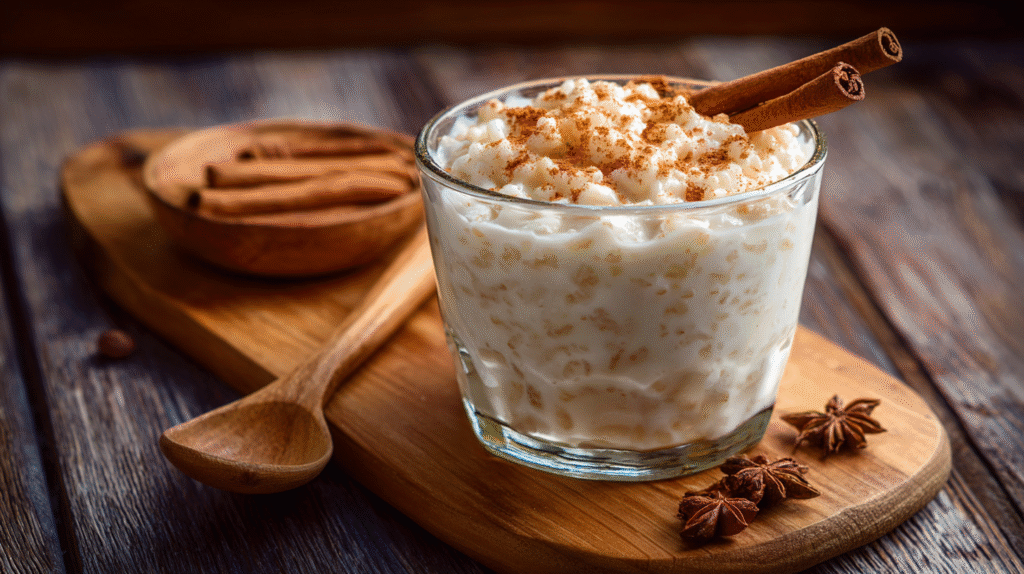
This homemade rice pudding recipe stands out from store-bought versions with its perfect balance of creamy texture and comforting flavor. Your family will request this dessert again and again for its nostalgic appeal and satisfying sweetness.
Every spoonful delivers a velvety consistency that comes from slowly simmering rice with milk until it reaches that ideal pudding texture. The gentle cooking process allows the rice to release its natural starches creating a dessert that’s naturally thick without artificial thickeners.
This recipe uses simple pantry staples you likely already have on hand making it perfect for unexpected dessert cravings. Many rice pudding fans appreciate that it doesn’t require special trips to the grocery store or exotic ingredients.
The versatility of this dish truly shines when you consider all the possible variations. You can serve it warm on chilly evenings for maximum comfort or chilled during summer months for a refreshing treat. Rice pudding also works beautifully as both a humble weeknight dessert and an elegant finish to dinner parties when presented in pretty dishes with thoughtful garnishes.
Preparing this pudding creates an aromatic experience as vanilla and cinnamon fill your kitchen with irresistible scents. These familiar fragrances often trigger happy memories for many people connecting the dish to childhood comforts and family traditions.
Best of all this pudding requires minimal active cooking time while delivering maximum flavor results. Your effort mainly involves occasional stirring while the stovetop does most of the work transforming simple ingredients into something truly special.
Ingredients You’ll Need
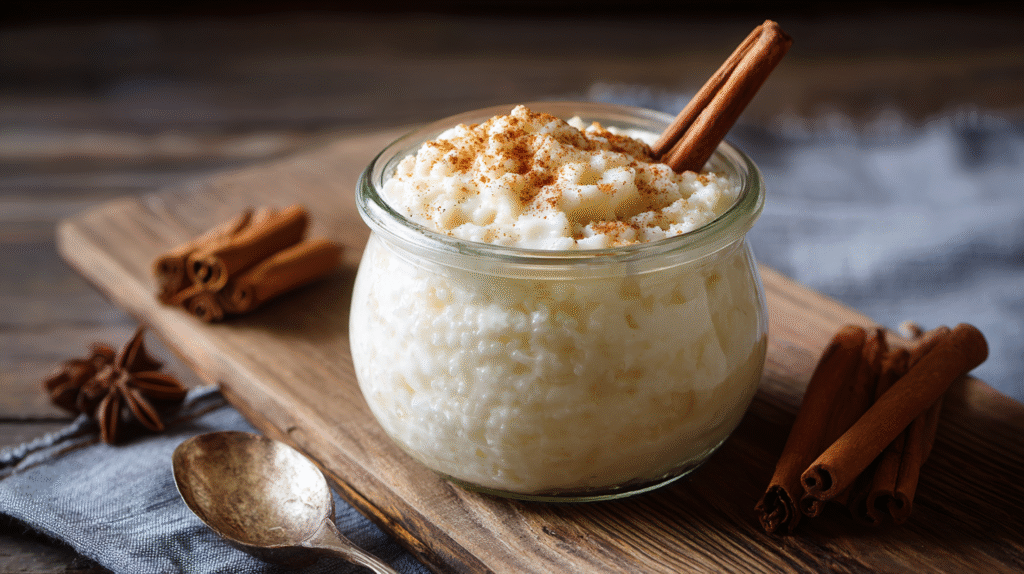
Creating the perfect rice pudding requires just a handful of everyday ingredients you likely already have in your pantry. Let’s break down what you’ll need to create this creamy comfort dessert.
Basic Ingredients
- 1 cup short-grain white rice (Arborio or pudding rice works best)
- 4 cups whole milk
- ½ cup granulated sugar
- 2 tablespoons unsalted butter
- 1 teaspoon pure vanilla extract
- ¼ teaspoon salt
- 2 large eggs (optional for extra richness)
- ½ teaspoon ground cinnamon
Optional Add-Ins
- ½ cup raisins or golden raisins (soaked in warm water for 10 minutes)
- ¼ cup dried cranberries
- ⅓ cup chopped nuts (almonds, pistachios, or walnuts)
- 2 tablespoons orange or lemon zest
- 2 tablespoons maple syrup (can replace some of the sugar)
- ¼ cup heavy cream (for extra richness)
- 2 tablespoons brown sugar (for topping)
- ½ teaspoon cardamom or nutmeg
- ¼ cup shredded coconut
- 1 tablespoon rum or bourbon (for adults-only versions)
Equipment Needed
Preparing homemade rice pudding requires minimal kitchen tools making it accessible for cooks of all skill levels. Here’s what you’ll need to create this creamy comfort dessert:
- Medium to large saucepan (3-4 quart capacity)
- Wooden spoon or silicone spatula
- Measuring cups and spoons
- Timer
- Heatproof serving dish or individual ramekins
The heavy bottomed saucepan is crucial for even heat distribution preventing the rice from scorching during the slow cooking process. Your wooden spoon or silicone spatula will become your best friend as you’ll need to stir frequently to achieve that perfect creamy consistency without scratching your cookware.
Standard measuring cups and spoons ensure accuracy with ingredients especially for first-time rice pudding makers. A timer helps track cooking intervals allowing you to monitor the pudding’s progress without constant supervision.
Consider having heatproof serving dishes ready before finishing your pudding. Individual ramekins create an elegant presentation for dinner parties while a family-style serving bowl works wonderfully for casual gatherings.
No specialized equipment is necessary for this classic dessert which is part of its enduring appeal. Most kitchens already contain these basic tools making rice pudding an approachable recipe whenever the craving strikes.
How To Make Rice Pudding
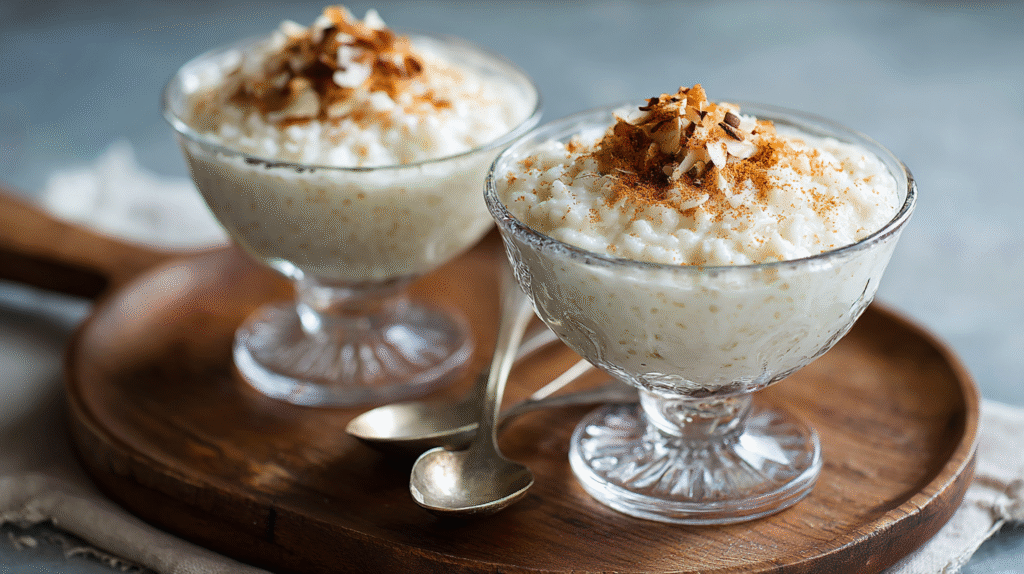
Creating perfect rice pudding is easier than you might think. The process involves just a few simple steps that transform basic ingredients into a creamy, comforting dessert.
Preparing The Rice
Begin by rinsing 1 cup of short-grain rice under cold water until the water runs clear. This removes excess starch and prevents your pudding from becoming too gummy. Pour the rinsed rice into your heavy-bottomed saucepan along with 4 cups of whole milk. For an extra rich version, you can substitute one cup of the milk with heavy cream. Stir the mixture gently to prevent the rice from sticking to the bottom of the pan before turning on the heat.
Cooking The Pudding
Place your saucepan over medium-low heat and bring the mixture to a gentle simmer. Once simmering, reduce the heat to low to maintain a bare bubble. Stir the pudding frequently (about every 3-5 minutes) to prevent scorching and promote even cooking. The rice will gradually absorb the milk while releasing its starches, creating that signature creamy texture. This process takes approximately 25-30 minutes. You’ll know the pudding is ready when the rice is tender and the mixture has thickened considerably but still remains slightly fluid, as it will continue to thicken as it cools.
Adding Flavors
When the rice is fully cooked and the mixture has thickened, it’s time to incorporate your flavors. Stir in 1/2 cup of sugar and 1 teaspoon of vanilla extract. For traditional rice pudding, add 1/2 teaspoon of ground cinnamon and a pinch of salt to enhance the overall flavor profile. This is also the perfect moment to fold in optional add-ins like plumped raisins, dried cranberries, or toasted nuts. For richer pudding, temper an egg by whisking a small amount of the hot pudding into a beaten egg, then stir this mixture back into the pudding. Cook for an additional 2 minutes, stirring constantly. Remove from heat and transfer to serving dishes while still warm, or chill in the refrigerator for a refreshing cold dessert.
Tips For Perfect Rice Pudding Every Time
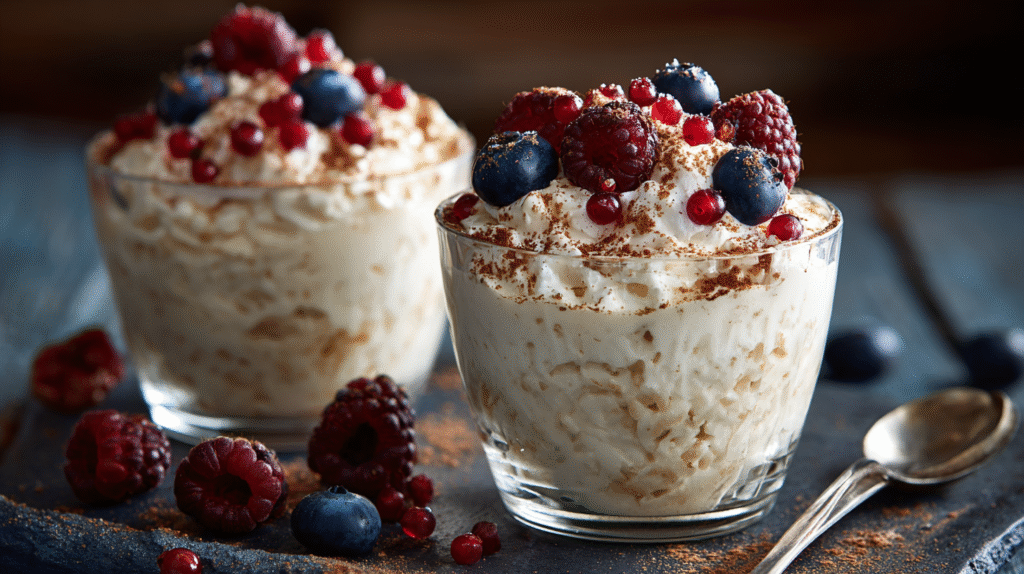
Choose the Right Rice
Select short-grain rice varieties like arborio jasmine or sushi rice for the creamiest results. These types contain more starch than long-grain varieties which helps create that signature silky texture. Short-grain rice absorbs liquid more effectively while maintaining its structure throughout the cooking process. Avoid using instant or parboiled rice as they won’t release enough starch to achieve the classic pudding consistency.
Mind Your Heat
Cook your rice pudding over low to medium-low heat throughout the entire process. High temperatures can cause the milk to scorch on the bottom of the pan or the rice to cook unevenly. Patience pays off when making rice pudding as the slow cooking allows starches to release gradually creating that perfect velvety consistency. Your stovetop should be just hot enough to maintain a gentle simmer without reaching a rolling boil.
Stir Consistently
Make stirring a regular habit while cooking rice pudding especially during the first 10-15 minutes. This prevents the rice from sticking to the bottom of the pan and helps distribute heat evenly. You don’t need to stir constantly but checking and stirring every 3-4 minutes makes a important difference in texture. The more you stir the creamier your pudding will become as it helps release additional starch from the rice.
Milk Matters
Use whole milk for the richest flavor and creamiest texture in your rice pudding. For an even more luxurious version try substituting part of the milk with heavy cream. Plant-based milk alternatives work too but each creates different results—coconut milk adds tropical notes while almond milk produces a lighter pudding. The fat content in your milk directly affects the richness of the final product so choose accordingly based on your preference.
Perfect Your Timing
Allow your rice pudding to cook until the rice is tender but still has a slight bite to it. Undercooked rice creates an unpleasant crunchy texture while overcooked rice dissolves into mush. Most rice puddings need 25-30 minutes of simmering but factors like rice type and heat level can affect this timeframe. Remember that pudding continues to thicken as it cools so remove it from heat when it’s slightly thinner than your desired final consistency.
Add Eggs Correctly
When incorporating eggs into rice pudding use a tempering technique to prevent scrambling. Take a small amount of the hot pudding mixture and slowly whisk it into your beaten eggs before adding the egg mixture back to the pot. This gradually raises the temperature of the eggs without cooking them instantly. Adding tempered eggs creates a custard-like richness that elevates traditional rice pudding to a new level of decadence.
Find Your Sweetness Level
Start with less sugar than you think you need since you can always add more later. Different add-ins like raisins or fruit contribute their own sweetness to the final dish. Taste your pudding about 5 minutes before it’s done cooking to adjust sweetness according to your preference. Alternative sweeteners like honey maple syrup or brown sugar can replace white sugar to create different flavor profiles.
Master the Finishing Touches
Add vanilla extract and spices after removing the pudding from heat to preserve their aromatic qualities. Extracts contain alcohol that evaporates when heated too long taking flavor compounds with it. Fold in mix-ins like raisins or nuts during the last few minutes of cooking or after removing from heat. The residual warmth will plump dried fruits without making them mushy while maintaining the texture of other additions.
Variations To Try
Rice pudding serves as a perfect canvas for culinary creativity. Try these delicious variations to transform this classic comfort food into exciting new desserts that will impress family and friends.
Coconut Rice Pudding
Transform your traditional rice pudding into a tropical delight by incorporating coconut elements. Replace half or all of the whole milk with full-fat coconut milk to create a rich and creamy base with distinct tropical flavor notes. Add 1/3 cup of shredded unsweetened coconut during the last 5 minutes of cooking for enhanced texture and flavor depth. Garnish your finished pudding with toasted coconut flakes for a beautiful presentation and satisfying crunch. For an extra touch of paradise, mix in 1 teaspoon of coconut extract along with your vanilla or replace the granulated sugar with palm sugar for authentic Southeast Asian flair. This variation pairs exceptionally well with fresh mango or pineapple pieces served on top or alongside.
Chocolate Rice Pudding
Chocolate lovers will delight in this decadent twist on classic rice pudding. Add 1/3 cup of cocoa powder along with the sugar during cooking, whisking thoroughly to prevent lumps. For a richer chocolate experience, stir in 1/2 cup of semi-sweet or dark chocolate chips after removing the pudding from heat, allowing the residual warmth to melt them completely. Enhance the chocolate flavor with a splash of coffee or espresso which intensifies the cocoa notes without adding coffee taste. Top your chocolate rice pudding with whipped cream and chocolate shavings for an elegant presentation. Consider adding 1/4 teaspoon of cinnamon or a tiny pinch of cayenne pepper to create a Mexican chocolate variation with subtle warmth and complexity.
Fruit-Infused Options
Fresh or dried fruits add natural sweetness and vibrant flavor to rice pudding. Fold in 1 cup of fresh berries like strawberries, blueberries, or raspberries just before serving for bright bursts of flavor and color. Create an apple cinnamon variation by adding 1 cup of diced sautéed apples with extra cinnamon and a dash of nutmeg. Dried fruits work beautifully when cooked with the rice—try 1/2 cup of chopped dried apricots, cherries, or cranberries added halfway through cooking time. For a tropical twist, incorporate diced mango or pineapple with a sprinkle of toasted coconut. Poached pears make an elegant addition when sliced and arranged atop each serving with a drizzle of their poaching liquid. You can also create a bananas foster rice pudding by caramelizing sliced bananas in butter and brown sugar, then spooning this warm mixture over each serving.
Storage And Reheating Instructions
Rice pudding stores exceptionally well making it perfect for advance preparation or enjoying leftovers. Once your pudding has cooled completely transfer it to an airtight container and refrigerate for up to 5 days. The texture will thicken considerably in the refrigerator which many people actually prefer.
For freezing rice pudding place it in a freezer-safe container leaving about half an inch of headspace to allow for expansion. Properly stored rice pudding maintains its quality in the freezer for up to 3 months. Label your container with the date to keep track of freshness.
Reheating chilled rice pudding requires adding a splash of milk to restore its creamy consistency. Warm it gently on the stovetop over low heat stirring frequently to prevent scorching. You’ll need approximately 1-2 tablespoons of milk per cup of pudding depending on your desired thickness.
Microwave reheating offers a quicker alternative for single servings. Place your portion in a microwave-safe bowl add a tablespoon of milk and heat in 30-second intervals stirring between each until reaching your preferred temperature. This method typically takes 1-2 minutes total depending on your microwave’s power.
Frozen rice pudding should thaw overnight in the refrigerator before reheating. Never attempt to reheat frozen pudding directly as this creates an uneven texture and potentially scorched spots.
Signs of spoilage include an off smell sour taste or visible mold. When in doubt about freshness always discard the pudding rather than risking foodborne illness. Rice pudding with dairy ingredients should never sit at room temperature for more than 2 hours.
Individual portions stored in small containers or ramekins make reheating more convenient and help maintain the dessert’s quality by limiting repeated temperature changes to the entire batch.
Serving Suggestions
Rice pudding’s versatility makes it perfect for countless serving styles that can elevate this humble dessert to impressive heights. Serve your homemade rice pudding warm from the stove for the ultimate comfort food experience during chilly evenings. Alternatively refrigerate it for several hours to enjoy a refreshingly cool dessert during warmer months.
Create an elegant presentation by spooning rice pudding into glass dessert cups or ramekins topped with a sprinkle of cinnamon or freshly grated nutmeg. Garnish with a mint leaf for a restaurant-worthy appearance that will impress dinner guests.
Transform your rice pudding into a breakfast option by layering it with fresh seasonal fruits and granola in a parfait glass. This creates a balanced morning meal that satisfies your sweet tooth while providing nutritional benefits.
For holiday gatherings arrange individual servings on a decorative tray with complementary toppings like pomegranate seeds for Christmas or candied pecans for Thanksgiving. Your rice pudding can become the centerpiece of a dessert table when presented with various toppings for guests to customize their portions.
Build a rice pudding bar for parties featuring small bowls of different toppings such as:
- Fresh berries (strawberries blueberries raspberries)
- Toasted nuts (almonds walnuts pistachios)
- Dried fruits (cranberries apricots cherries)
- Sweet drizzles (honey maple syrup caramel sauce)
- Spices (cinnamon cardamom nutmeg)
- Chocolate (shaved dark chocolate white chocolate chips)
- Coconut flakes
- Fruit preserves or compotes
Pair your rice pudding with complementary beverages for a complete dessert experience. Coffee particularly espresso creates a delightful contrast with the sweet creaminess of rice pudding. Tea options like chai masala or Earl Grey also make excellent accompaniments.
Consider serving rice pudding as part of a dessert trio with small portions alongside chocolate mousse and fruit sorbet for an impressive dinner finale. This allows guests to sample different flavors and textures in one sophisticated dessert course.
Make-Ahead Options
Rice pudding shines as an excellent make-ahead dessert option that actually improves with time. You can prepare a large batch up to 3 days before serving for maximum convenience without sacrificing quality. After cooking your pudding completely, allow it to cool at room temperature for about 30 minutes before transferring it to an airtight container and refrigerating.
For best results, store the pudding without any toppings or garnishes that might become soggy. Fresh fruits, toasted nuts, or whipped cream should be added just before serving to maintain their texture and flavor. The pudding will naturally thicken as it cools, so consider this when determining your desired final consistency.
Planning for a special event? Make individual portions by dividing the pudding among small glass jars or ramekins before refrigerating. This approach not only creates an elegant presentation but also eliminates last-minute serving stress. Simply remove from the refrigerator about 20 minutes before serving to take the chill off slightly.
Freezing works surprisingly well for rice pudding when properly prepared. Portion your cooled pudding into freezer-safe containers, leaving about half an inch of space at the top for expansion. The frozen pudding maintains quality for up to 3 months when stored at 0°F or below. Thaw overnight in the refrigerator for the best texture restoration before gently reheating if desired.
Rice pudding makes an excellent component in a prepared dessert tray. You can assemble a beautiful dessert board with individual cups of rice pudding alongside complementary items like shortbread cookies, fresh berries, and chocolate-dipped spoons up to 24 hours before your event.
The History Of Rice Pudding
Rice pudding boasts a remarkably diverse history that spans thousands of years and crosses many cultures around the industry. Ancient records show that rice pudding originated as early as 2000 BCE in China where rice was first domesticated and cultivated extensively. The earliest versions were simple mixtures of rice cooked with water or milk until they formed a thick porridge.
In medieval Europe rice pudding emerged as a luxury dish reserved for the wealthy because rice had to be imported from Asia at great expense. European variations typically included eggs sugar and exotic spices like cinnamon nutmeg and saffron which demonstrated the host’s wealth and status. By the 16th century rice pudding had become a staple in royal courts across Europe particularly in England where it evolved into a beloved national dish.
The dessert gained widespread popularity during the colonial era when rice production expanded globally. British colonists brought their rice pudding recipes to America where the dish was adapted using local ingredients and cooking methods. In the southern United States rice pudding incorporated influences from African culinary traditions resulting in variations that often included molasses and sometimes cornmeal.
Throughout Latin America rice pudding appears as “arroz con leche” featuring distinctive additions like citrus zest cinnamon sticks and condensed milk. Middle Eastern cultures created their own versions called “ruz bil laban” or “muhallabia” often flavored with rose water orange blossom water and pistachios. In India “kheer” represents one of the oldest forms of rice pudding dating back to ancient Hindu texts where it was offered as a sacred food to deities.
Nordic countries developed their own tradition of rice pudding called “risgrynsgröt” which became integral to Christmas celebrations. The Danish and Swedish custom of hiding an almond in the pudding and rewarding the finder with a special gift continues to this day.
The industrial revolution transformed rice pudding from a labor-intensive homemade dish into a commercially available product. Canned rice pudding appeared on market shelves in the early 20th century making this once-special dessert accessible to everyone regardless of cooking skill or economic status.
Today rice pudding continues to evolve with modern chefs experimenting with innovative flavors like matcha lavender and caramel while home cooks often return to traditional family recipes passed down through generations. This humble dish demonstrates remarkable versatility adapting to local tastes and ingredients while maintaining its core identity as the ultimate comfort food.
Conclusion
Rice pudding isn’t just a dessert—it’s a culinary journey that connects generations and crosses cultural boundaries. With just a few simple ingredients from your pantry you can create a comforting treat that’s infinitely adaptable to your taste preferences.
Whether you serve it warm on a chilly evening or chilled as a refreshing summer dessert the creamy texture and gentle sweetness will satisfy cravings and create moments worth savoring. You’ll find the process itself wonderfully therapeutic as the gentle simmer fills your kitchen with irresistible aromas.
So grab your saucepan and wooden spoon—your perfect rice pudding awaits. This timeless classic proves that sometimes the simplest recipes deliver the most extraordinary pleasures.

